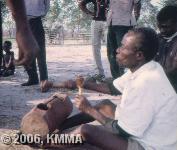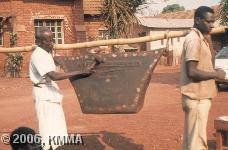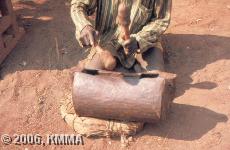


The slit drum is an idiophone drum, made from a hollowed piece of wood in which a narrow groove serves as a sound opening. The slit drum is struck with a stick along both sides of the narrow groove, which produces two different pitches. The possibility of combining rhythm with pitch enables the slit drum to act as a means of communication for tone-language tribes such as the Bantu.
The KMMA collection currently includes 421 slit drums, with a few exceptions all from the Congo. They provide a complete overview of all types of slit drum that were and still are played in the Congo.
The three most common types are the cylindrical, the trapezoid and the zoomorphic. Besides these we also find them in the form of a tulip, half-moon and boat.
The basic structure of the drum is virtually the same for each type and is best illustrated by the cylindrical slit drum. A block of wood, usually part of a tree trunk, is cut into the desired shape and then hollowed out through the slit in the upper side. The drum-maker/woodcutter ensures that the two sides of the drum are unequal in thickness so that different pitches are produced when played with two rubber-headed drum sticks. The two-tone structure will later form the basis for the transmission of a message, the purpose for which these instruments are best known.
The creativity of the drum-maker and woodcutter is clearly visible in the way the upper side around the slit is decorated. This can be done by making the simple cut for the slit and by adding two "sound holes" at each end, or by decorating the area around the slit with geometric patterns.
This type of slit drum occurs over the entire Congo, with a clear preponderance in the southern part (Kwango, Katanga, Central Basin, Lower Congo and Maniema). The name broadly used for this type of slit drum is the mondo or kyondo, although several other names are also used sporadically according to the ethnic group.
While dealing with cylindrical slit drums, mention should also be made of the smaller, anthropomorphic slit drum from the Kwango and Lower Congo (Yaka, Holo, Suku), which is characterised by its smallness and by the anthropomorphic decoration (a head) that acts as a handle. This drum is played exclusively by the féticheur-healer who thereby summons protective spirits and communicates with them.
Larger slit drums are of the trapezoidal type. The name is self-explanatory, being large instruments, also monoxylic, which take the form of a trapezium. It is placed either on the ground or carried around on the player’s shoulder by a strong rope while playing.
This type of slit drum is found in a large area of the Congo: Central Basin, Maniema, Kasai, Katanga, Kivu and Kwango, and is called by several names (lukumbi, nkumvi).
Besides functioning as a signal instrument, the trapezoidal slit drum is also frequently incorporated into ensembles for entertainment music, where its deep tones make it ideal for a rhythmic bass.
J.S. Laurenty, the organologist at the KMMA (1965 – 1991) described the exceptionally beautiful form of this slit drum as a "tulip". It is found exclusively in the Uele (Mangbetu, Zande and Mamvu) under several names. The artistry with which this slit drum is cut proves once again that for some tribes the creative element is paramount. The Mangbetu and Zande are famous for their beautifully elegant sculptures and, in morphological terms, extend this to larger objects such as the slit drum.
It is striking, however, that this type of slit drum is always played in pairs by one musician, a fact that is also clear to see on the drums in our collection from that fact that they only show traces of playing on one side of the drum. The photograph below shows how the musician plays. However, it is not clear why this particular technique is chosen.
As in other regions of the Congo, this slit drum is also played in larger ensembles together with other instruments, as a percussion instrument during dances and festivals.
Related to this drum type is the slit drum in a "half moon" shape that is typical of the Zande and related tribes where it is called dundu. This type has a simpler structure, but requires great dexterity and substantial skill, considering the resources the cutter has at his disposal. He has to hollow out a relatively thin log in such a way that two walls of unequal thickness are left. Apart from this, the instrument is used in the same way as the previous type in hierarchical and musical events
In the category of slit drums, one type attracts particular attention because of its form but also because it is not intended as a signal instrument. We refer here to the boat-shaped drum, which is rather limited in its dimensions but still often beautifully decorated with all sorts of motifs. Moreover, the underside of this small slit drum has a serrated edge which is often used as a scraper. Its distribution area on the banks of the Congo estuary, populated by the Kongo and Woyo peoples, and its specific role in the life of the African, together with other details, give it a specific identity from three points of view: manufacture, origin and role in traditional life. It is most especially the decorations that make this instrument so specific. Besides the dark-brown patina on the oldest specimen, some specimens also have one side red, and the other white. The sculptures and notches applied, mostly on one side of the instrument, often have geometric patterns, besides images from the animal and plant kingdons. This small instrument, the nkonko, was used in the Lower Congo during the lemba cult, by the master-cutter in the nkanda circumcision ceremony, by the healer or nganga who plays it during the healing ritual, and also during the ceremonies of secret societies. In addition, one observer notes that this drum is played as an accompaniment to the circle dancing by the women of Mayombe; possibly a ritual. He says that the small slit-drum is attached to the back, on the hips of each dancer and is played with a stick by the woman who follows in the dance.
Since it is played exclusively in this context, and is not used to send messages, it is not surprising that the interval between the two tones is very slight, not to say often nonexistent.
The so-called zoomorphic slit-drums are impressive in shape and occur in both large and small sizes. The term is self-explanatory; these slit-drums are made from one extremely large block of wood and are shaped into a stylised animal (buffalo, antelope). They are distinguished by a large trunk which serves as a sound box. On one side of it is a sculpted stylised neck and head and on the other side a tail. This head and tail are not necessarily always recognizable; some types only have an identical wooden point on each side. In order to add extra emphasis to the shape of the animal, the "trunk" stands on four wooden feet.
It is also striking that the large zoomorphic monganze and mokoto drums come virtually exclusively from the Ubangi region (Loi, Ngbaka, Ngombe, Lobala), while the smaller version, the gugu, is found especially in the Uele region (Mamvu, Zande, Mangbetu, Barambo). The first function of these drums is communicative yet this does not preclude their role during dancing, when it is played as a rhythm instrument in a larger ensemble. Whereas it is almost a law that the possession of such instruments is the privilege of the chief and certain eminent figures as a symbol of their power and prestige within the group, in the Barambo tribe everyone is allowed to own this type of slit drum.
Range of the sound found in the slit drum
An instrument that has the specific task of transmitting messages must naturally meet certain standards. The slit drum is a clear example of this and the range of the sound depends on several factors: the volume of the instrument, atmospheric and topographical factors, and the force with which the instrument is struck. Since water is an ideal acoustic vehicle, the riverbank is used as a place to set up the slit drum.
When it comes to voluminous slit drums (e.g. the large zoomorphic or cylindrical drums) we find they are played to transmit messages to the surrounding villages, which implies they need to be able to cover a considerable distance (10 to15 km).
Taking into account the fact that slit drums are virtually the exclusive possession of local chiefs and are thus also used to transmit messages across the entire territory he dominates, the slit drums of villages situated further away will act as a sort of relay. For example, the first drum transmits a message, the next drum passes it on, etc., until the message has been sent to the whole area for which it was intended.
The drummer
Playing the slit drum remains the privilege of certain people in the village who are trained to do so. Not only must they know how to signal messages but must also be able to play sufficiently well and this is not a skill that everyone can acquire. This means that the learner drummer must first be thoroughly trained by an established drummer, whose place he will later take. Not everyone can play a slit drum, but virtually everyone understands the signal language.
On the social front, the signal drummer does not automatically have any special status within the group, and in contrast to other musicians, playing the instrument does not form the basis of his daily tasks, neither does he live solely from his music. An exception to this rule is found among the Tetela, where the drummer occupies a special place on the fringes of society. Playing the slit drum is a purely male occupation; the women do not play the instrument but understand its language.
The drum language
Understanding the language of the drum is itself a difficult task for the uninitiated. The signal language is based on the spoken (Bantu) language, which is a tonal language, i.e. one particular word consisting of a number of possible syllables can have a different meaning according to the pitch at which the syllables are pronounced. Since we are dealing with tribes who are ‘illiterate’, the spoken language therefore has a very great impact on daily life and transmitting messages is therefore very strictly structured.
In terms of the language and the words themselves each drummed sentence is a sort of encoded description of the core term that has to be signalled, e.g. about the chief, a birth, a death, inviting the notables for a meeting, a special occurrence or event in the group, etc.
Also the consecutive order of the different drummed sentences is fixed:
1) requesting attention
2) declaring who is sending the message
3) delivering the content
4) ending the message
This type of instrument is used in recordings of our sound archives made with the Congolese peoples mentioned hereafter where it appears with the following vernacular names:
Bakpekpe (Budu), Boungou (Lokele), Bugu (Zande), Chondo (Kanyoka), Condo (Luba-Kasai), Dundu (Pygmées), Ebgbge (Pygmées), Emandru (Medje), Gbugbu (Gbandi, Mayogo), Gogo (Mamvu), Gudugudu (Ndo), Gudu-gudu (Abangba), Gugu (Zande), Igogo (Pygmées), Igogo deja (Budu), Igogo tade (Budu), Ikokola (Boyela, Ngando), Ikokole (Batwa, Bolia, Ekonda, Twa), Ikole (Mongala), Ikookole (Mongo), Kandji (Ngoma) (Kongo), Kankonko (Sala Mpasu), Khoko (Kongo), Kiyondo (Songye), Kyondo (Luba), Lenga (Gubu), Lokele (Bongando), Lokole (Batwa, Boyela, Ekonda, Elinga, Enga, Kutu, Mongo, Ndengese, Nkundu, Saka), Lokolé (Mongo, Mputu), Lokombe (Boyela, Ndengese, Tetela), Lokombe (Lukumbe) (Mongo), Lokuku (Ekonda), Lukumbe (Hamba, Mondja, Tetela), Lunkufi (Songye), Magbo (Mayogo), Makpo (Budu / Mbuti), Makpo (Kpokpo) (Pygmées, Pygmées), Mandru (Mangbetu), Mgungu (Mbuti), Mokoto (Binza), Molonge (Sengele), Mond (Lunda), Mondo (Kongo, Kwese, Mpangu, Suku, Tshokwe, Yaka), Mongungu (Ngombe), Mpopwo (Bari), Mudimba (Kanyoka, Luba), Mungungu (Bali), Mutumba (Lunda, Sala Mpasu), Ndundu (Pygmées), Nedundu (Medje), Nekbokbo (Medje), Nekpokpo (Mangbetu), Nemandru (Mangbetu), Nengwangu (Mayogo), Ngombi (Boa), Ngoto (Lobala), Ngufu (Yaka), Nkoko (Yaka), Nkombe (Lokombe) (Boyela), Nkonko (Kongo), Nkumvi (Luba), N'kupila (Yaka), Shakudi (Mongo, Tetela), Tshikunvu (Lunda), Tshingoma (Kongo), Tshingufu (Chokwe, Tshokwe), Wungu (Hamba), Yeye (Mayogo)
Discography:
© KMMA